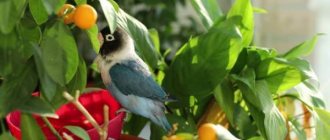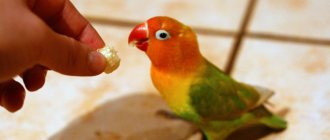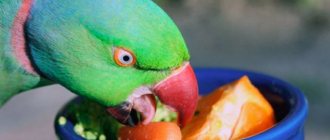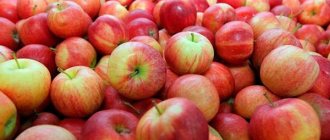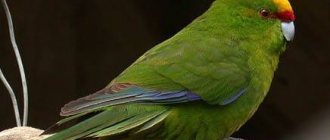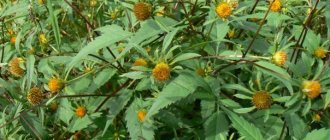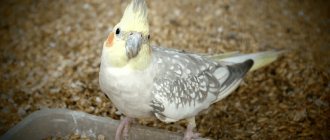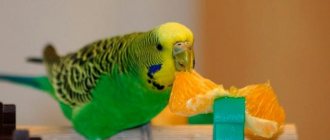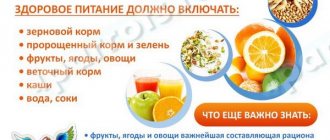Can parrots eat porridge?
Porridge is given to wavy animals of any age. It is recommended to start introducing them into the diet from birth. Small chicks are fed liquid mixtures of wheat and semolina. Crushed eggshells, almost ground into flour, are added to the finished dish. Newly hatched parakeets are syringe fed.
How to prepare porridge and feed the chick in the first days.
With regular consumption of porridge, wavy animals acquire strong immunity against infectious diseases. This is explained by the fact that cereals saturate the body with B vitamins, microelements and proteins. And the presence of fiber in them regulates the functioning of the digestive organs.
Nuts
Nuts are a source of fatty acids and vitamins. They have a beneficial effect on the skin, plumage and brain function. However, they should be given in limited quantities: 1-2 times a month, a small piece.
You can give:
- pine nuts;
- coconut;
- cashew nuts;
- Walnut;
- Brazilian nut;
- almond;
- hazelnut.
Excessive consumption of nuts negatively affects digestion, because... they are too fatty and high in calories for pets.
Greenery
It is advisable to include greens in the daily diet, especially in the summer. It is useful to give your parrot fresh greens, which are a source of useful elements:
- clover;
- lettuce leaves;
- carrot and beet tops;
- plantain;
- burdock;
- dandelion;
- scalded nettle leaves;
- leaves of fruit trees, willow;
- green cereals;
- knotweed;
- spruce needles (without branches).
The grass should be collected selectively, in separate shoots, since when picked in bunches, there is a high probability of taking a poisonous plant. Grass and branches are not collected along roads and near industrial enterprises.
You can give parrots some house plants:
- green chlorophytums;
- palm trees;
- tradescantia;
- citruses;
- roses;
- bamboo;
- hibiscus;
- aloe and kalanchoe;
- chrysanthemums.
It is better to place plants that are edible for birds in the same room with the cage, while poisonous ones should be taken to another room and avoid their contact with the bird.
Animal feed and additives
A minor but important component of a parrot’s diet is animal products. They are given in a separate feeder as they spoil quickly.
The list is very limited:
- honey - added in small quantities to porridge or water;
- low-fat cottage cheese - as a source of calcium (up to 2 times a week, 2 tbsp.);
- low-fat fermented milk products (kefir) improve digestion;
- quail and chicken eggs - well-boiled, 1-2 times a week.
In small quantities, to compensate for nutritional deficiencies, you can give:
- sand – to improve digestion;
- chalk - to strengthen the skeleton;
- eggshells (boiled);
- bone flour;
- sepia (clam shell);
- calcium gluconate;
- charcoal (birch) - to cleanse the body and as a source of microelements;
- vitamin supplements.
You should not abuse their quantity and skimp on the quality of vitamin supplements, because a lack of vitamins and minerals in a parrot’s body will lead to serious consequences.
What grains are used for cooking
The most valuable porridges for a budgie are buckwheat, oatmeal, rice and pearl barley. Since millet is the basis of your feathered pet’s diet, boil it and gradually add other ingredients to the mixture. Millet should not exceed half of the total poultry diet.
1/4 Parrot menuPreparing for breeding. How to properly cook porridge for a parrot
List of allowed cereals:
- oatmeal;
- rice;
- buckwheat;
- wheat;
- corn;
- barley;
- pearl barley
Do not cook the porridge until fully cooked; it should be slightly damp. Oatmeal and buckwheat can be brought to a boil, then removed from heat, cover and leave for half an hour. It is also acceptable to steam cereals in a thermos. To do this, simply pour boiling water over them, cover and let sit for 6 hours.
Millet
This cereal does not require long cooking. Bring it to a boil, leave for 10-15 minutes and remove from heat. If you want to enrich millet with useful substances, add crushed boiled eggs or pieces of fruit.
porridge for parrots (basic)
Buckwheat
You can cook this porridge or steam it in a thermos. In the first case, fill it with water and keep it on the fire after boiling for 10 minutes. Then leave to simmer for half an hour. If you cook in a thermal mug, pour boiling water over the cereal and close the container with a lid. The dish will be ready in 6 hours.
Oatmeal
For oatmeal, buy regular cereal without additives and slow cooking. Fill them with water and cook for 10-15 minutes.
Jachka
Crushed cereals are useful for small chicks and parrots weakened by illness, as they are a good source of energy and are easier to digest in the gastrointestinal tract. Healthy parrots should be fed whole grains. Boil the cell for 10-15 minutes or steam in a thermos. You can mix it with grated raw carrots.
Porridge for parrots. Cooking porridge for Toshenka and Chika
Brown rice
Experienced breeders recommend using only wild and brown rice. The cereals are cooked for about 20-25 minutes, removed from the heat and simmered under the lid for half an hour.
Legumes – mung bean, peas, lentils
Soak the grains overnight and cook for 20-30 minutes in the morning. Cook red, green and pink lentils without soaking. Give green and brown ones in a soaked form.
Corn
This cereal takes a long time to prepare and requires pre-soaking for 6 hours. Cook for 20-25 minutes, serve warm.
Nut mixes
The grain feed contains nuts. Sometimes they are more focused than the birds' needs. It is recommended to remove parts of the nut so as not to damage the liver. Not all types of nuts will be suitable for your animal. For example, peanuts should not be offered because they may be affected by mold, which causes a dangerous disease.
Avoid fruit seeds:
- Cherry for birds;
- cherries;
- plums;
- apricots.
Bitter almond kernels are not very good food for parrots. Somewhat more beneficial are sweet almonds, pistachios, Peces and macadamia nuts.
Porridge recipes
Porridge can be made from one or several types of cereals. It is useful to enrich dishes with vegetables and fruits. Here are two recipes with different ingredients and cooking methods.
Cooking porridge for budgies and other parrots, part 3
Boiled mixture with vegetables
Pour an equal portion of cereals into the pan: buckwheat, oatmeal, brown rice. Rinse them with running water.
Cooking:
- Pour a small amount of water over the cereal.
- Cook for 10-15 minutes.
- Remove from heat and simmer covered for half an hour.
- Wait until it cools down; if there is any water left, drain it.
Before feeding your pet, sprinkle the dish with grated vegetables. The porridge should not be too soft; the parrot should easily grasp it with its beak.
A mixture of cereals steamed in a thermal mug
Take several types of cereals: buckwheat, pearl barley, corn, red lentils, mung bean, rice and millet. Rinse and place in a thermos or thermal mug.
PORridge FOR A BUDGY PARROT!
Preparation of the mixture:
- Pour boiling water over the cereals.
- Leave to steam for 6 hours.
- Pour the mixture out of the container and drain the water.
- Add sprouted mung bean grains and a drop of honey.
Birds also have their own taste preferences. Choose the types of cereals that your pet loves. See what consistency he likes best. If the parrot is more willing to eat crumbly porridge, then evaporate the liquid completely, and if it is thick, then add more water when cooking.
Fruits
A budgie or lovebird that has just found a new home should be offered to try the pulp instead of balanced dry food or together with it:
- oranges;
- tangerines;
- grapefruit;
- lime
Poultry will not refuse banana and pineapple, watermelon puree and melon. You don’t have to remove the peel from the fruit, but before filling the feeder with fruit, you will have to wash it with warm water and soda. Many budgies eat all the berries that are offered to them.
But, for example, viburnum is prohibited as the main food for lovebirds with kidney disease, but healthy birds love it (it should be given in small portions, freed from seeds).
Fruits and berries are given fresh or defrosted. There are few contraindications, the only thing, for example, is that the aratingas do not like mangoes. Moreover, this fruit is contraindicated for them, so before purchasing anything exotic for your pet, you should make sure that a particular fruit or berry is safe for its body. If you cannot find out on your own about the safety of a particular fruit or vegetable or food, you need to contact a veterinary clinic.
Kalina.
Mango.
Dried fruits purchased in the store, before distributing to feeders, are soaked and washed in warm water, using a toothbrush, and any dust or debris that may stick to their surface is cleaned out. Both dried fruits and fresh berries are pitted. Pears, apples, apricots, peaches, plums, quinces and grapes are divided into several parts and completely cleared of stems and peels. Accordingly, there should be no seeds in them.
Some lovebirds love pomegranates. But since they themselves consist of seeds, before transferring the fruit to the bird, the skin is removed from it. When feeding fruits and berries, you should never overdo it; for example, grapes can be fed daily, but not allowing the bird to eat more than 3-4 berries at a time. Otherwise, the same lovebird may develop food poisoning or indigestion.
Pomegranate.
Grape
How to give correctly
Having assessed all the benefits of the feed, it is necessary to decide in what form it is best to introduce it into the bird’s diet. Let's look at the possible options.
Sprouted oats
It’s easy to germinate oats for feeding a parrot yourself. To do this, the grain (it is better to buy it at a pet store) is first thoroughly washed and then soaked in a shallow bowl. After this, the grains are laid out on a flat surface and covered with wet gauze.
When the gauze dries, it must be sprayed with water. The sprouts should emerge within 24 hours. It is impossible to germinate grain for a very long time , since in sprouts that are too long, the amount of nutrients decreases.
If the raw material for germination was of poor quality, the bird may be poisoned. Therefore, you should be especially careful when choosing grain. Grains that have small spots on them, as well as those that have not sprouted, cannot be given to the parrot.
It is necessary to introduce sprouted spikelets into the parrot's diet gradually. At the same time, carefully monitor the bird’s reaction. In the future, you can give sprouted oats every day. It will be a good supplement especially in winter, when poultry may experience a deficiency of nutrients.
In the form of dry food
By giving the bird oat grains, you can pre-prepare them. To do this, they need to be steamed with water for several hours, the grains will swell, and it will be easier for the parrot to chew them. Such preparation is possible, but not required. As a rule, parrots are good at chewing dry oats.
Not all oat grains can be given to a parrot. For example, grain prepared for planting should never be used to feed poultry . It may be treated with pesticides.
Even if oats were purchased at a pet store, they must be carefully inspected before giving them to your pet. A large number of broken grains, as well as grains with blackened seeds, indicate poor quality of the product.
When purchasing ready-made food for a parrot, you also need to make sure that it contains oats. Typically, the basis of such feeds is millet; the mass fraction of oats should be about 10%. Nowadays there are a huge number of brands of ready-made dry food on the market. When choosing the one that best suits your parrot, you should pay attention to mixtures that also contain pieces of dried fruits and vegetables.
